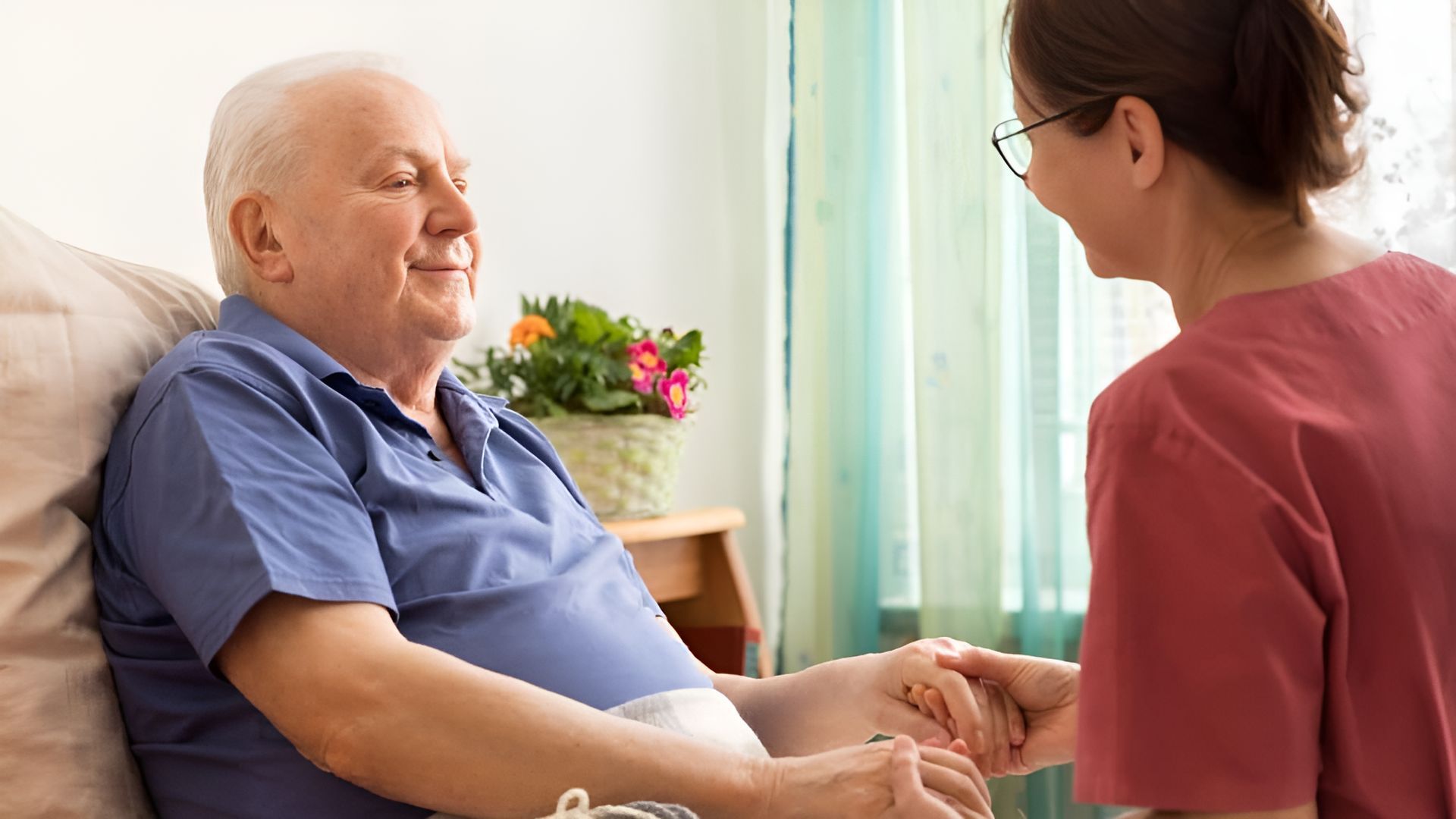Effective Parkinson’s Care at Home Solutions

Effective Parkinson’s Care at Home Solutions
Providing compassionate care for loved ones with Parkinson’s is of utmost importance. In this article, we will explore various strategies and solutions to effectively care for individuals with Parkinson’s in the comfort of their own homes. Whether you are a caregiver or a person with Parkinson’s, this guide will equip you with the knowledge and resources to ensure a safe, comfortable, and supportive environment.
From at-home care for Parkinson’s patients to Parkinson’s disease care at home, we will cover various topics, including safe home environments, adaptive products, personalized living areas, Parkinson ‘s-friendly kitchen and bathroom adaptations, and technology incorporation. Additionally, we will address the long-term care needs of individuals with Parkinson’s aging in place.
Furthermore, we understand the role of caregivers in the Parkinson’s care journey. We will provide insights on how to be a proactive caregiver, strategies for medication management, and the importance of open communication and attending medical appointments together. We aim to support and empower caregivers to provide the best possible care.
Join us on this enlightening and informative journey as we explore Parkinson’s care at home. Discover practical solutions, innovative products, and actionable advice to help create a nurturing and supportive environment for individuals with Parkinson’s in their homes. With the right tools and strategies, we can make a significant difference in the quality of life for those with Parkinson’s.
Continue reading to discover the array of resources and solutions available to assist you in providing adequate care for your loved ones with Parkinson’s at home.
Understanding Parkinson’s and Its Home Care Needs
Parkinson’s disease is a progressive neurodegenerative disorder that affects millions of individuals worldwide. It primarily affects the central nervous system, leading to a wide range of symptoms and challenges in daily life. Understanding the impact of Parkinson’s on individuals and their home care needs is crucial for providing practical support and assistance. Let’s explore the common symptoms of Parkinson’s disease and how it can be managed at home.
Common Symptoms of Parkinson’s Disease
Both motor and non-motor symptoms characterize Parkinson’s disease. Motor symptoms include:
- Tremors or shaking, often starting in the hands or fingers
- Rigidity and stiffness in the muscles
- Bradykinesia or slowness of movement
- Postural instability, leading to balance problems and difficulty walking
In addition to these motor symptoms, individuals with Parkinson’s may also experience non-motor symptoms such as:
- Depression and anxiety
- Sleep disturbances
- Cognitive changes, including memory loss and difficulty with attention and problem-solving
- Speech and swallowing difficulties
Home Care Needs for Parkinson’s Patients
Managing Parkinson’s at home requires a comprehensive understanding of the care needs of individuals with the condition. These needs may include:
- Assistance with activities of daily living (ADLs) such as dressing, bathing, and grooming
- Medication management to ensure adherence and optimal symptom control
- Creating a safe and accessible home environment to prevent falls and accidents
- Providing emotional support and companionship to alleviate feelings of isolation and depression
- Encouraging physical exercise and therapy to maintain mobility and strength
Managing Parkinson’s at Home
Although Parkinson’s disease is a chronic and progressive condition, various strategies and approaches can be adopted to manage the symptoms and improve the quality of life at home. These may include:
- Working closely with healthcare professionals to develop a personalized care plan
- Implementing assistive devices and adaptive technologies to promote independence
- Creating a supportive and comfortable living environment that addresses specific needs
- Engaging in physical therapy and exercise programs tailored for Parkinson’s patients
- Establishing a solid support network of family, friends, and caregivers
By understanding the unique challenges of Parkinson’s disease and addressing individuals’ specific home care needs, it is possible to create an environment that promotes comfort, safety, and well-being. The following sections will explore the key elements of a safe home environment, adaptive products for promoting independence, personalizing the living area, and more.
Critical Elements of a Safe Home Environment
To create a safe home environment for individuals with Parkinson’s, there are several vital elements to consider. These elements will help ensure the safety and well-being of the person living with Parkinson’s and provide peace of mind for caregivers.
Smoke and Carbon Monoxide Detectors
Installing smoke and carbon monoxide detectors throughout the home is crucial for creating a safe environment. These detectors serve as early warning systems, alerting individuals to potential fire or gas hazards. Regularly check and maintain these detectors to ensure they are in proper working order.
Reducing Fire Hazards
Fire hazards can pose a significant risk to individuals with Parkinson’s. To minimize this risk, it is essential to take precautions such as:
- Keep flammable materials, such as curtains and furniture, away from heat sources.
- Avoid using space heaters or candles unsupervised.
- Regularly inspect electrical cords for fraying or damage and replace them as needed.
- Turn off appliances, such as stoves and irons, when not in use.
Clutter-Free Spaces and Secure Furniture
Creating clutter-free spaces is essential for preventing falls and accidents. Ensure that walkways and hallways are clear of obstacles, and remove any unnecessary furniture or decorations that could pose a risk. Additionally, secure furniture to walls to prevent tipping and install handrails in areas where extra support is needed, such as staircases and bathrooms.
| SAFE HOME ENVIRONMENT FOR PARKINSON’S PATIENTS | PARKINSON’S HOME SAFETY | CREATING A SAFE HOME FOR PARKINSON’S |
|---|---|---|
| Install smoke and carbon monoxide detectors | Avoid fire hazards | Create clutter-free spaces |
| Regularly check and maintain detectors | Keep flammable materials away from heat sources | Secure furniture to prevent tipping |
| Avoid using space heaters or candles unsupervised | Install handrails in areas that need extra support |
Promoting Independence with Adaptive Products
Living with Parkinson’s disease can present various challenges that can impact an individual’s independence. However, adaptive products can play a significant role in promoting independence and improving daily life for individuals with Parkinson’s. By utilizing these innovative products, individuals can maintain their autonomy, communicate effectively, and engage in their favorite activities more efficiently.
Writing Aids for Improved Communication
Communication can become more challenging for individuals with Parkinson’s due to difficulties with speech and writing. However, there are adaptive products available that can enhance communication. Writing aids, such as pens with larger grips or weighted utensils, can help individuals with tremors maintain control while writing. Additionally, speech-to-text software or apps can make it easier to communicate ideas and thoughts.
Assistive Devices for Daily Activities
Performing daily activities can become more challenging for individuals with Parkinson’s. Fortunately, various assistive devices are designed to make these activities more manageable. Devices like buttonhooks and zipper pulls can assist with dressing, while specialized utensils and adaptive kitchen tools can aid in meal preparation. These devices allow individuals to maintain their independence and perform tasks more efficiently.
Mobility Aids
Individuals with Parkinson’s may experience mobility issues, making it challenging to navigate their surroundings. Mobility aids can provide the necessary support to help individuals move safely and independently. Items such as canes, walkers, and rollators can provide stability and help reduce the risk of falls. In addition, motorized scooters or wheelchairs can help individuals maintain mobility and explore the world around them.
By utilizing adaptive products, individuals with Parkinson’s can regain a sense of independence and improve their overall quality of life. These products enhance communication, assist with daily tasks, and empower individuals to participate in their daily routines actively. Living independently can contribute to a sense of autonomy and well-being for individuals with Parkinson’s.
Personalizing the Living Area
To create a comfortable home for individuals with Parkinson’s, it is crucial to personalize the living area to cater to their specific needs and preferences. You can enhance their overall well-being and quality of life by making strategic adjustments and incorporating elements that promote comfort and support. Here are some tips on how to create a personalized living area for Parkinson’s patients:
- Arrange furniture for easy mobility: Ensure ample space to navigate around the living area, allowing for easy movement and minimizing the risk of falls. Consider removing unnecessary obstacles and arranging furniture in a way that provides clear pathways.
- Choose supportive seating: Opt for furniture that offers adequate support and comfort, such as chairs with armrests or recliners. This will help individuals with Parkinson’s maintain proper posture and reduce fatigue.
- Use contrasting colors: Incorporate contrasting colors in the living area to improve visual perception and reduce the risk of tripping or bumping into objects. For example, use contrasting colors on walls, furniture, and floor coverings to enhance visibility.
- Install proper lighting: Ensure the living area is well-lit with adjustable lighting options. This can help individuals with Parkinson’s manage symptoms such as reduced visual acuity and improve overall safety.
- Create a calming atmosphere: Use soothing colors, natural elements, and personal mementos to create a peaceful and comforting ambiance. This can help reduce stress and anxiety, promoting a sense of well-being.
- Avoid clutter: Keep the living area organized and free from clutter to minimize the risk of tripping or falling. Use storage solutions such as baskets, shelves, or cabinets to stow away items neatly.
| TIP | BENEFITS |
|---|---|
| Arrange furniture for easy mobility | – Reduces the risk of falls , Facilitates easy movement |
| Choose supportive seating | – Provides comfort and support, Helps maintain proper posture |
| Use contrasting colors | – Enhances visibility and reduces the risk of accidents, Improves visual perception |
| Install proper lighting | – Improves safety and visibility, Helps manage reduced visual acuity |
| Create a calming atmosphere | – Reduces stress and anxiety, Promotes a sense of well-being |
| Avoid clutter | – Minimizes the risk of tripping or falling, Makes the living area safer and more accessible |
By personalizing the living area, you can create a comfortable and supportive space that meets the specific needs of individuals with Parkinson’s. This enhances their physical well-being and contributes to their emotional and mental comfort. Everyone’s preferences and requirements may vary, so consulting with the individual and their healthcare team is crucial to ensure the living area is personalized effectively.
Adaptations for a Parkinson’s-Friendly Kitchen
To make the kitchen a more accessible and functional space for individuals with Parkinson’s, it is essential to implement specific adaptations. These adaptations focus on strategic storage solutions, specially designed utensils, and adjustable countertop heights.
Strategic Storage Solutions
When designing a Parkinson ‘s-friendly kitchen, it is crucial to consider storage solutions that make it easy to access and organize items. Some key strategies include:
- Installing pull-out shelves and drawers to minimize the need for reaching and stretching.
- Using lazy susans or rotating trays in corner cabinets maximizes storage space and improves accessibility.
- Organizing cabinets and drawers by category makes locating and retrieving items easier.
Specially Designed Utensils
Using utensils specifically designed for individuals with Parkinson’s can significantly enhance their ability to prepare and enjoy meals independently. Here are some examples:
- Weighted utensils that provide stability and reduce hand tremors, making it easier to grasp and control cutlery.
- Utensils with built-up handles offer a more secure and comfortable grip, reducing the risk of spills and accidents.
- Adaptive kitchen tools, such as angled and rocker knives, require less effort and dexterity.
Adjustable Countertop Heights
Having countertops at the right height can significantly improve the accessibility and ergonomics of a kitchen for individuals with Parkinson’s. Some options to consider include:
- Installing height-adjustable countertops that can be raised or lowered to accommodate different individuals’ needs and preferences.
- Use pull-out cutting boards or work surfaces positioned comfortably for meal preparation.
- Ensuring adequate knee space under the countertops allows individuals to sit or use a stool while working in the kitchen.
| ADAPTATION | BENEFITS |
|---|---|
| Strategic Storage Solutions | – Easy access to kitchen items, Organization and efficiency |
| Specially Designed Utensils | – Improved grip and control, Reduced risk of spills and accidents |
| Adjustable Countertop Heights | – Customizable for individual needs, Increased comfort and ergonomics |
Creating a Comfortable and Accessible Bedroom
Creating a safe and comfortable bedroom is essential for individuals with Parkinson’s. By incorporating accessible design elements and thoughtful considerations, you can ensure a restful environment that promotes independence and safety. Here are some tips to help you create an accessible and comfortable bedroom for Parkinson’s care:
Bed Accessibility Aids
Choose a bed with appropriate height and support to facilitate easy entry and exit for Parkinson’s patients. Adjustable beds can provide added convenience, allowing individuals to find the most comfortable sleeping position. Consider installing bed rails or grab bars to provide additional support and stability.
Trip-Free Pathways and Nighttime Safety
Clear any clutter or obstacles from the bedroom to create trip-free pathways. Utilize proper lighting, such as motion-sensor nightlights, to ensure visibility during nighttime movements. Arrange furniture in a way that allows for easy navigation, and consider using slip-resistant flooring to minimize the risk of falls.
By designing a bedroom that is accessible, comfortable, and safe, you can enhance the quality of life for individuals with Parkinson’s. These modifications can help promote independence, reduce the risk of accidents, and provide a supportive environment for a good night’s rest.
Parkinson’s Home Care Assistance in the Bathroom
Providing proper home care assistance in the bathroom is crucial for individuals with Parkinson’s to maintain their safety and independence. Adapting the bathroom to meet the unique needs of Parkinson’s patients ensures a comfortable and secure environment. Here are some tips and strategies for creating a bathroom that prioritizes bathroom safety for Parkinson’s patients:
Install Grab Bars:
Installing grab bars near the toilet and shower can provide stability and support for individuals with Parkinson’s. These bars should be securely mounted to the walls and positioned appropriately for easy access.
Use Non-Slip Mats:
Place non-slip mats on the bathroom floor and inside the shower or bathtub to prevent slips and falls. These mats provide an added layer of traction and stability, reducing the risk of accidents.
Adjust Shower Accessibility:
Consider installing a handheld showerhead with a long hose to allow Parkinson’s patients to shower while seated. This adjustable feature provides flexibility and convenience, enabling individuals to maintain their independence while bathing.
Organize Bathroom Essentials:
Keep bathroom essentials within easy reach to minimize the risk of falls or accidents. Place toiletries, towels, and other necessities in inaccessible storage areas or install shelves and organizers that can be easily reached without excessive bending or stretching.
Ensure Adequate Lighting:
Good lighting is essential in preventing accidents in the bathroom. Install bright, well-positioned light fixtures and nightlights to ensure visibility, especially during nighttime bathroom visits.
By implementing these adaptations and safety measures, individuals with Parkinson’s can confidently navigate the bathroom and maintain independence.
| ADAPTATIONS | BENEFITS |
|---|---|
| Grab Bars | Provide stability and support |
| Non-Slip Mats | Prevent slips and falls |
| Adjustable Showerhead | Enable seated showers |
| Organized Storage | Minimize risk of accidents |
| Adequate Lighting | Enhance visibility and safety |
Practical Home Renovation Tips for Parkinson’s Patients
When renovating a home for individuals with Parkinson’s, it is crucial to prioritize universal design principles and consider their long-term accessibility needs. By making thoughtful adaptations, you can create a safe, comfortable, and functional living space that enhances their quality of life. Here are some practical home renovation tips to guide you:
Prioritizing Universal Design
Universal design focuses on creating spaces that are accessible and usable by people of all abilities. When renovating a home for Parkinson’s patients, prioritize the following universal design principles:
- Wide doorways and hallways to accommodate mobility aids and ensure easy movement throughout the house.
- Zero-step entry or a ramp for smooth and barrier-free access.
- Smooth, slip-resistant flooring to prevent falls. Avoid rugs or use non-slip mats.
- Easy-to-reach light switches and electrical outlets.
- Well-lit areas with natural and artificial lighting to enhance visibility.
Considering Long-Term Accessibility Needs
As Parkinson’s is a progressive condition, it is essential to consider the long-term accessibility needs of individuals during home renovations. Keep the following in mind:
- To support and prevent falls, install grab bars and handrails in strategic areas such as staircases, bathrooms, and hallways.
- Choose lever-style door handles and faucets that are easier to operate for individuals with tremors or limited dexterity.
- Plan for future accessibility needs, such as incorporating space for a wheelchair or walker if mobility declines.
- Consider adjustable height countertops and cabinets to accommodate different levels of mobility and prevent strain.
By implementing these practical home renovation tips and considering the specific needs of individuals with Parkinson’s, you can create a living space that promotes safety, comfort, and independence. Remember to consult with professionals, such as occupational therapists or certified contractors, to ensure that the renovations align with the unique requirements of Parkinson’s care.
| RENEVATION TIPS | BENEFITS |
|---|---|
| Prioritize universal design principles | Enhanced accessibility for individuals with Parkinson’s, regardless of ability |
| Consider long-term accessibility needs | Future-proofing the home to accommodate changing mobility requirements |
Incorporating Technology and Emergency Preparedness
Emergency Contact Systems
One crucial aspect of Parkinson’s care at home is ensuring that emergencies are handled promptly and effectively. Implementing an emergency contact system is essential for providing security to individuals with Parkinson’s and their caregivers. A reliable emergency contact system can ensure immediate assistance, minimize potential risks, and provide peace of mind.
Using Assistive Technology for Daily Tasks
Technology has revolutionized our lives and can be a valuable tool in Parkinson’s care. There are various assistive technologies available that can help individuals with Parkinson’s perform daily tasks more independently and efficiently. From voice-activated devices to medication reminder apps, assistive technology offers innovative solutions to enhance the quality of life for individuals with Parkinson’s and their caregivers.
| BENEFITS OF EMERGENCY CONTACT SYSTEMS | BENEFITS OF ASSISTIVE TECHNOLOGY |
|---|---|
| Immediate access to help in case of emergencies | Enhanced independence in performing daily tasks |
| Provides a sense of security for individuals with Parkinson’s | Improved medication management and compliance |
| Enables caregivers to respond quickly and effectively | Reduces caregiver burden and stress |
| Minimizes potential risks and accidents | Increases efficiency and accuracy in task execution |
By incorporating technology and emergency preparedness strategies into Parkinson’s care at home, individuals with Parkinson’s can experience an improved quality of life, increased independence, and enhanced safety. Using emergency contact systems and assistive technology can provide peace of mind for individuals with Parkinson’s and their caregivers, ultimately promoting a more secure and comfortable living environment.
Aging in Place with Parkinson’s Care at Home
As individuals with Parkinson’s age, the desire to maintain independence and stay in the comfort of their own homes becomes increasingly important. Aging in place with Parkinson’s care at home provides a sense of familiarity and security that can contribute to overall well-being. Implementing long-term care strategies for individuals with Parkinson’s is crucial to ensure their safety, health, and quality of life.
Long-term care for Parkinson’s involves addressing the specific needs and challenges that arise as the disease progresses. It requires a comprehensive approach to provide physical, emotional, and cognitive support. By adapting the home environment, incorporating assistive devices, and implementing personalized care plans, individuals with Parkinson’s can continue to age in place and receive the care they need.
Some of the critical considerations for long-term care for aging individuals with Parkinson’s include:
- Modifying the home environment to enhance safety and accessibility
- Assisting with daily activities and personal care
- Managing medications effectively
- Implementing regular exercise and physical therapy
- Ensuring regular medical check-ups and monitoring disease progression
It is essential for caregivers and loved ones to collaborate with healthcare professionals specializing in Parkinson’s care to develop a personalized care plan that addresses individual needs and promotes overall well-being. With the proper support, aging individuals with Parkinson’s can maintain their independence, dignity, and quality of life while remaining in the familiar surroundings of home.
| BENEFITS OF AGING IN PLACE WITH PARKINSON’S CARE AT HOME | CHALLENGES OF AGING IN PLACE WITH PARKINSON’S |
|---|---|
| Preservation of familiar environment | Ongoing management of symptoms |
| Reduced stress and anxiety | Potential increased caregiving responsibilities |
| Enhanced comfort and emotional well-being | Home modifications and accessibility needs |
| Promotion of social connections and support | Ensuring availability of necessary resources and support |
| Opportunity for personalized care | Balancing caregiving with personal well-being |
Being a Proactive Caregiver
As a caregiver for individuals with Parkinson’s, being proactive is essential in providing the best possible care and support. Here are some tips to help you be a proactive caregiver:
Open Communication and Honest Conversations
Effective communication is vital in understanding the needs and concerns of your loved one with Parkinson’s. Encourage open and honest conversations to establish trust and foster a supportive environment. Listen actively, ask questions, and empathize with their emotions and experiences. This open communication will enable you to understand their needs and provide personalized care.
Attending Medical Appointments Together
Accompany your loved one to their medical appointments. This allows you to stay informed about their condition, treatment plan, and any changes in medication or therapy. It also allows them to ask questions, clarify information, and actively participate in healthcare decisions. Attending appointments strengthens your caregiving partnership and ensures you have the most up-to-date knowledge and guidance from healthcare professionals.
By being a proactive caregiver, prioritizing open communication, and attending medical appointments together, you can provide the best possible support and care for your loved one with Parkinson’s.
Strategies for Medication Management
Effective medication management is crucial for individuals with Parkinson’s disease, as it plays a vital role in managing symptoms and improving overall quality of life. Organizing medications and adhering to medication schedules is essential to ensure optimal results. Here are some tips for managing Parkinson’s medications:
- Establish a Routine: Create a consistent medication schedule to maintain a steady level of medication in the body. This helps control symptoms and reduces fluctuations.
- Use Pill Organizers: Invest in pill organizers to separate medications by day and time. This helps prevent confusion and ensures that medications are taken as prescribed.
- Set Reminders: Utilize alarm clocks, smartphone apps, or medication reminder devices to help you remember when to take medications. Consistency is vital in managing Parkinson’s symptoms effectively.
- Communicate with Healthcare Providers: Keep your healthcare team informed about any changes in medication efficacy or side effects. They can provide guidance and make necessary adjustments to the treatment plan.
- Keep Medication List Updated: Maintain an updated list of all medications, dosages, and schedules. This helps prevent medication errors and ensures healthcare providers have accurate information during appointments.
- Include a Caregiver or Family Member: Involve a trusted caregiver or family member in medication management. They can provide support reminders and help monitor any changes in medication needs.
By implementing these strategies and staying organized, individuals with Parkinson’s can effectively manage their medications, enhance symptom control, and improve their overall well-being.
Conclusion
Throughout this article, we have explored various effective Parkinson’s care at-home solutions designed to improve the quality of life for individuals living with Parkinson’s disease. By implementing these strategies, caregivers can provide compassionate and personalized care in the comfort of their loved one’s home.
We have emphasized the importance of creating a safe home environment, promoting independence through adaptive products, personalizing the living area, and adapting key areas such as the kitchen, bedroom, and bathroom. These modifications enable individuals with Parkinson’s to maintain their dignity and autonomy while ensuring their safety and well-being.
Additionally, we have discussed the significance of incorporating technology and emergency preparedness into Parkinson’s care and the benefits of aging in place. Caregivers can provide the necessary support and ensure optimal symptom management for their loved ones by proactively and effectively managing medication.
In conclusion, providing adequate care for individuals with Parkinson’s at home requires a comprehensive approach that addresses their unique needs and challenges. By implementing the home care solutions discussed in this article, caregivers can create a supportive and nurturing environment that promotes independence, safety, and comfort, ultimately enhancing the overall well-being of their loved ones.
Effective Parkinson's Care at Home Solutions FAQs
What is Parkinson's disease?
Parkinson’s disease is a neurodegenerative disorder that affects movement and coordination. Tremors, stiffness, impaired balance, and slow movement characterize it.
How can Parkinson's disease impact an individual's daily life?
Parkinson’s disease can significantly impact daily activities and tasks. It may affect mobility, stability, communication, and cognitive function. Fatigue and muscle weakness can also be expected, making it challenging to perform everyday tasks.
How can I create a safe home environment for someone with Parkinson's?
To create a safe home environment for someone with Parkinson’s, installing smoke and carbon monoxide detectors, reducing fire hazards, and maintaining clutter-free spaces are essential. Securing furniture and using non-slip mats can help prevent falls and accidents.
What adaptive products can promote independence for individuals with Parkinson's?
Various adaptive products are available, such as writing aids for improved communication, assistive devices for daily activities, and mobility aids like canes or walkers. These products can help individuals with Parkinson’s maintain their independence at home.
How can I personalize the living area for someone with Parkinson's?
Personalizing the living area for someone with Parkinson’s involves creating a comfortable and supportive environment. This can be done by considering their needs and preferences, such as providing adequate seating, good lighting, and organizing belongings for easy access.
What adaptations can be made to the kitchen to make it Parkinson 's friendly?
Adapting the kitchen for someone with Parkinson’s may involve using strategic storage solutions, specially designed utensils for easier gripping, and adjustable countertop heights to accommodate different physical abilities.
How can I create a comfortable and accessible bedroom for someone with Parkinson's?
A comfortable and accessible bedroom for someone with Parkinson’s can be achieved using bed accessibility aids, such as bed rails or grab bars. Ensuring trip-free pathways and incorporating nighttime safety measures, like nightlights, can also help promote a safe sleep environment.
What home care assistance can be provided in the bathroom for individuals with Parkinson's?
Home care assistance in the bathroom for individuals with Parkinson’s can include:
- Installing grab bars near the toilet and shower.
- Using non-slip mats.
- Consider accessible shower or bath options, such as walk-in tubs or roll-in showers.
What are some practical home renovation tips for Parkinson's patients?
When renovating a home for Parkinson’s patients, it is essential to prioritize universal design principles, such as wider doorways and lever-style door handles. Considering long-term accessibility needs and incorporating features like stair lifts or ramps can also be beneficial.
How can technology and emergency preparedness support Parkinson's care at home?
Technology can play a role in Parkinson’s care by utilizing emergency contact systems, such as medical alert devices, and assistive technology for daily tasks. These technologies can provide peace of mind and improve safety and independence for individuals with Parkinson’s.
What is aging in place, and how can it relate to Parkinson's care at home?
Aging in place refers to individuals choosing to remain in their homes as they age. In the context of Parkinson’s care, it involves implementing long-term care strategies that support individuals with Parkinson’s in maintaining their independence and quality of life at home.
How can I be a proactive caregiver for someone with Parkinson's?
Being a proactive caregiver for someone with Parkinson’s involves open communication and honest conversations. Attending medical appointments together can also help ensure proper care coordination and support for the caregiver and the individual with Parkinson’s.
What are some strategies for medication management for individuals with Parkinson's?
Effective medication management for individuals with Parkinson’s includes organizing medications, setting reminders, and adhering to medication schedules. Working closely with healthcare professionals to ensure optimal symptom management and minimize potential side effects is crucial.










